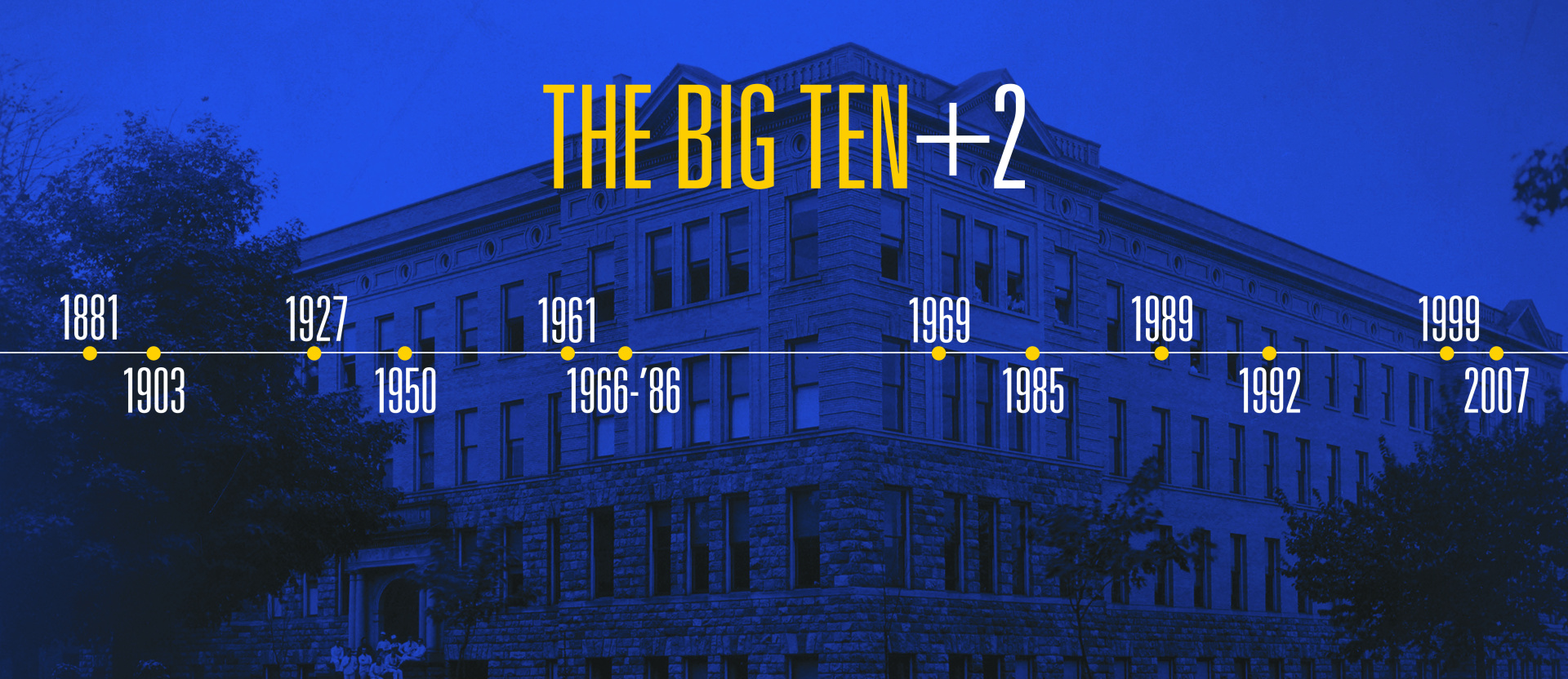
1881-2019 The Big Ten +2
Throughout our history, we have changed the game in the environmental fields through the innovations and achievements of our alumni, faculty, and students.
Here are just a few of our "leaders and best."
1881
FIRST U.S. COURSES IN THE SCIENCE OF FORESTRY
U-M became the first institution in the U.S. to offer forestry courses as an integral part of the curriculum. Dr. Volney Morgan Spalding—who championed the course—was himself a botanist and aware of the need to place forestry on a sound scientific foundation. Housing the course in the School of Political Science reflected Spalding’s recognition of forestry’s influence on the social and economic welfare of the country.
1903
NEW DEPARTMENT OF FORESTRY PIONEERS FIELD-BASED LEARNING
“Week after week, he [Filibert Roth] sent his ‘boys’ packing on foot out to Saginaw Woods, an 80-acre reserve at Ann Arbor’s western edge. On this farmed-out plot—donated to U-M by Regent Arthur Hill (namesake of Hill Auditorium)—Roth’s students improved the soil and planted some 40 species of trees to see which would fare best.” –Michigan Today, 2017
1908
FIRST INSTRUCTION IN LANDSCAPE DESIGN
Ossian Cole (OC) Simonds, a U-M graduate and Chicago landscape designer, established the first professional program in landscape design at U-M, the second of its kind in the nation.
1927
SCHOOL OF FORESTRY AND CONSERVATION IS FIRST OF ITS KIND IN U.S.
“The word ‘conservation’ was added to the name of the school to indicate that its interpretation of forestry is much broader than the ordinary conception, and to emphasize the fact that in addition to the training of professional foresters, one of its important functions is to teach the philosophy of conservation as the fundamental basis of permanent national prosperity.”
– Samuel T. Dana, Michigan Alumnus, May 11, 1929.
1939
U-M AWARDS THE NATION'S FIRST PH.D IN LANDSCAPE ARCHITECTURE
The same year, the department of landscape design is transfered to the College of Architecture, and renamed "Landscape Architecture." Administration of the department returned to the School of Natural Resources in 1965, and moved from its location in the Cheever Building into the Dana Building in 1978.
1950
SNR PROFESSOR TEACHES THE FIRST U-M TELECOURSE
SNR Professor Karl F. Lagler (PhD ’40) taught the first university telecourse, and went on to complete more than one hundred educational television programs, as well as a weekly radio show on conservation from 1963 to 1972. Also in 1950, Lagler was instrumental in the establishment of the Department of Fisheries within SNR, and served as its chairman until 1965.
1961
FIRST AFRICAN AMERICAN PHD IN CONSERVATION: THEODORE R. SPEIGNER
Theodore R. Speigner (PhD ’61) was a vocal and inspiring advocate for increasing the presence and expertise of African Americans in the geography profession, particularly teachers. He went on to become the founder and chair of the North Carolina Central University Department of Geography.
1966-'86
LEADER IN THE DEVELOPMENT OF ENVIRONMENTAL LAW
SNR professor Joe Sax became the leading voice among scholars helping to develop the present-day American environmental law system. He also mentored hundreds of Michigan students, who went on to become leaders themselves in environmental law.
1969
FOUNDER OF ENVIRONMENTAL EDUCATION
William Stapp and his students formally developed and published the first paper that defined “environmental education” in 1969. Dr. Stapp is considered the “founder of environmental education” and spent his career searching for the root causes of environmental issues, and helping students and adults find solutions to problems affecting their communities.
1985
FIRST ENVIRONMENTAL MASTER’S PROJECTS
SNR was the first environmental school to offer team-based master’s projects, founded on the belief that problems are solved by teams in the real world. Students report that the interdisciplinary master’s projects, offered as an alternative to the traditional thesis, are an invaluable experience that prepares them to excel in the workplace.
1989
LEADERS IN ENVIRONMENTAL PSYCHOLOGY
The Experience of Nature: A Psychological Perspective, published in 1989 by Dr. Rachel Kaplan and husband Dr. Stephen Kaplan, introduced “restorative environments” and Attention Restoration Theory—concepts that would influence how generations of landscape design professionals and environmental psychologists view humanity’s relationship with nature.
1992
FIRST ENVIRONMENTAL JUSTICE PROGRAM
SNRE became the first and only school in the U.S. to launch an Environmental Justice program—spearheaded by Dr. Bunyan Bryant—that offered both undergraduate and graduate degree specializations.
1999
CENTER FOR SUSTAINABLE SYSTEMS (CSS)
CSS is an evolution of the National Pollution Prevention Center for Higher Education, which was created in 1991. Launched in 1999 by co-founders Jonathan Bulkley (left) and Greg Keoleian (right), CSS has become globally recognized as a leading academic center for life cycle assessment, systems analysis, interdisciplinary research, education, and outreach.
2007
FIRST NATIONAL SUMMIT TO ADDRESS CLIMATE CHANGE ADAPTATION
The “Coping with Climate Change National Summit,” organized by then SNRE Dean Rosina Bierbaum, along with other SNRE faculty, students and staff, focused on helping the citizens of the U.S. prepare for the future impacts of climate-based changes in temperature, precipitation, sea level rise, and species range.

